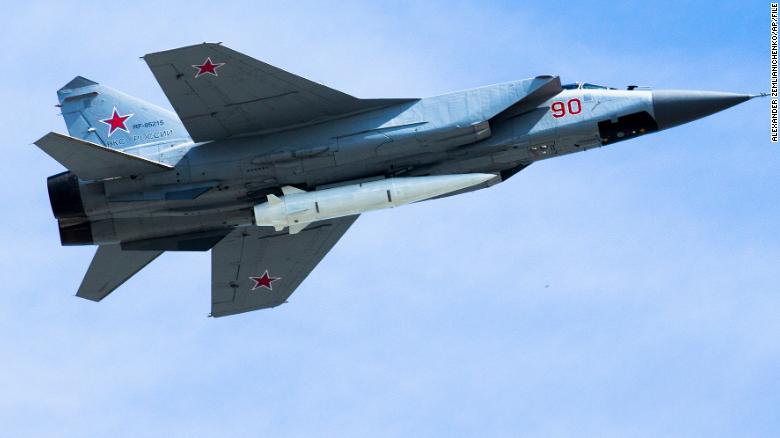Russia has used hypersonic missiles in its invasion of Ukraine, US President Joe Biden confirmed Monday.
“And if you’ll notice, (Russia has) just launched the hypersonic missile, because it’s the only thing that they can get through with absolute certainty,” Biden said. “It’s a consequential weapon … it’s almost impossible to stop it. There’s a reason they’re using it.”
But British intelligence and even Biden’s own defense secretary have downplayed Russia’s use of its air-launched Kinzhal missiles.
“I would not see it as a game changer,” Pentagon chief Lloyd Austin told CBS’ “Face the Nation.”
And the UK Defense Ministry said the Kinzhal missile is really just an air-launched version of the Iskander short-range ballistic missile (SRBM), which Russia has used repeatedly in its invasion of Ukraine.
Why the fear and hype about hypersonic missiles?
First, it’s important to understand the term.
Essentially, all missiles are hypersonic — which means they travel at least five times the speed of sound. Almost any warhead released from a rocket miles in the atmosphere will reach this speed heading to its target. It is not a new technology.
What military powers — including Russia, China, the United States and North Korea — are working on now is a hypersonic glide vehicle (HGV). An HGV is a highly maneuverable payload that can theoretically fly at hypersonic speed while adjusting course and altitude to fly under radar detection and around missile defenses.
An HGV is the weapon that’s almost impossible to stop. And Russia is thought to have an HGV in its arsenal, the Avangard system, which Russian President Vladimir Putin in 2018 called “practically invulnerable” to Western air defenses.

Does Ukraine have missile defenses?
The United States and its NATO allies are already sending several surface-to-air missiles systems to Ukraine to aid in its defense.
According to a senior US official, these additional systems include the Soviet-era SA-8, SA-10, SA-12 and SA-14 mobile air defense systems.
And NATO member Slovakia has agreed to send even better S-300 missile defense batteries to Ukraine once it gets suitable replacements from NATO partners, sources have told CNN.
Why did Putin use the Kinzhal missile?
Use in Ukraine marks the combat debut for Russia’s Kinzhal system.
“On March 18, the Kinzhal aviation missile system with hypersonic aeroballistic missiles destroyed a large underground warehouse of missiles and aviation ammunition of Ukrainian troops in the village of Delyatin, Ivano-Frankivsk region,” Russia’s Defense Ministry said.
CNN was unable to independently verify this claim.
US officials later confirmed to CNN that Russia launched hypersonic missiles against Ukraine and were able to track the launches in real time.
The launches were likely intended to test the weapons and send a message to the West about Russian capabilities, multiple sources told CNN.
And with the war on the ground in Ukraine becoming a stalemate, Russia may be looking for victories it can tout.
The UK Defense Ministry said Moscow probably deployed the Kinzhal to “detract from a lack of progress in Russia’s ground campaign.”
Austin, the US defense secretary, used similar language in his CBS interview, saying Putin is “trying to reestablish some momentum” in his invasion of Ukraine.
Austin asked whether the Russian military was running low on precision-guided munitions, or whether Putin lacked confidence in “the ability of his troops to reestablish momentum.”
“You kind of question why he would do this,” he said.
As reported by CNN
